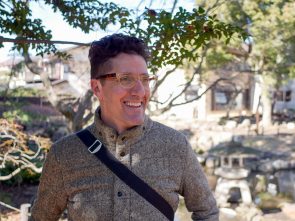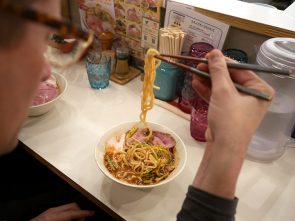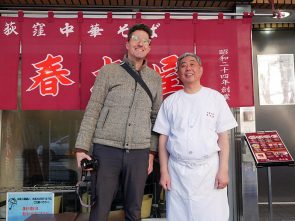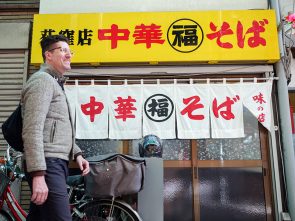- Name:
- Brian MacDuckston
- Profession:
- Ramen Blogger & Author
- Birthplace:
- San Francisco, CA, USA
- Current Residence:
- Shinjuku, Tokyo
- Web Site:
- http://www.ramenadventures.com/ (external link)
INTERVIEW WITH BRIAN MACDUCKSTON (RAMEN BLOGGER)
Brian MacDuckston has become one of the foremost English speaking authorities on the ramen scene in Japan, having visited over 1,400 shops around Japan. He has appeared on numerous television shows about ramen, written two books on the subject, and is one of the ramen critics for Ramen Walker, a popular Japanese ramen magazine. We at Experience Suginami Tokyo were lucky to have the opportunity to pick his brain over a few bowls about Japanese ramen and the foundation of its shoyu variety in our very own Ogikubo. This is the interview portion of “Ogikubo Ramen Adventures”.
[published March 2020]
Experience Suginami Tokyo: Brian, it’s a great pleasure to collaborate with you. Thank you for taking the time out of your busy schedule to bumble around Ogikubo and film us eating and talking about ramen. I first saw you on Japanese TV, but you started off as a ramen blogger, didn’t you? How did you get to where you are now?
Brian MacDuckston: The short story is that I just had a bowl of ramen I liked and started a blog. This was before social media was a thing, so I just used the blog as a way of keeping track of ramen shops I visited. At some point, I received some media attention and started focusing more and more on the site. Since then I’ve expanded to offer tours, produce YouTube videos, write books, and appear on Japanese TV.
EST: So which came first for you, Japan or ramen? In other words, is ramen something that brought you here or something that has kept you here?
BM: I came here, like most Americans, to teach English. Ramen was something I discovered in Japan.
EST: OK, so that’s how you got your start as a ramen lover, but how did you come to love it so much that you could keep eating it all of these years, over 1,000 bowls and still going?
BM: At first, I just loved the flavors. Eventually, it became an obsession, fueled by travel and discovering new places. If I just wanted to eat good ramen, I could probably stick with a few shops, but combining travel and ramen hunting around Japan is a passion.
EST: After eating so much ramen, I think a lot of our readers will want to know how you stay in shape. Although there are lots of ramen shops in Japan that are healthy with tons of veggies in their bowls, still, how do you maintain the lifestyle?
BM: We are having our interview in Ogikubo, so I cycled over here along Ome Kaido Road. I try and ride my bicycle everyday if my destination is less than an hour away.
EST: That’s right, you are a serious cyclist. I saw on Ramen Adventures that you have literal ramen adventures, cycling long distances with stops for ramen. And you also visit ramen shops all over the world. Which country outside of Japan has the tastiest ramen, in your opinion? And which is the most unique?
BM: That is tough to say because I consider many foreign ramen shop owners as great friends, so I couldn’t single any out. That said, most large cities around the world have a few decent shops.
EST: Usually Japanese ramen is divided into Tonkotsu, Shoyu, Shio, and Miso varieties. Do you have a favorite type of ramen? If so, what is it and why?
BM: I love a great miso ramen, but elegant shoyu ramen is the one that I think really shows off umami and Japanese cooking.
EST: OK, Next question is a bit harder—what is your favorite ramen shop? I don’t want you to feel pressure to say it is one in Suginami, so let me rephrase that: what are your current favorite ramen shops both inside and outside of Suginami?
BM: Yeah, that is a tough one. I think Uchoku in Ogikubo is really the pinnacle of refined shoyu ramen, so I’ll go with that. At this moment in time, I am craving something spicy, so I’ll go with Kikanbo in Kanda. They do a spicy miso ramen that is out of this world.
EST: In terms of ramen in Suginami, of course Ogikubo is the most well-known, although maybe not so famous. Nonetheless, you used to live in Ogikubo. Did that have a connection to your ramen adventuring?
BM: Totally. I started ramen hunting when I lived in Ogikubo, so I had plenty of nearby shops to try out. When you are strapped for time it is great to have dozens of good spots within cycling distance.
EST: You have published 2 books now—please tell us and our readers about them!
BM: I wrote a book with a Japanese publisher a few years back. This one is a guide to Tokyo ramen shops. Recently, I worked with an American publisher to make a cookbook called Ramen at Home. If people try making simple ramen in their own kitchens, I think they will appreciate Japanese ramen shops even more.
EST: Thanks again for taking the time with us. Lastly, could you tell us about your next ramen adventure?
BM: I began working with a famous Japanese ramen magazine called Ramen Walker. They have a nationwide best-of list, and I have only been to around ⅔ of these shops. So the goal now is to visit the rest of these shops. It isn’t easy, as many are in the deep countryside of Japan. I’ve been filming a lot of these adventures, and hope to make a youtube series out of it. Please check in on my social media from time to time to see any updates!

Brian MacDuckston

Brian "collecting data" on a spicy bowl at Koisaimen Inosho in Ogikubo

With Imamura-san, 2nd generation owner of "world famous" Harukiya

Brian is a ramen walker, hunter, cyclist, rider-- he travels where Ramen will take him, be it historical Ogikubo or other countries around the world

"Crushing" a satisfying bowl at Goryokaku in Ogikubo, it is easy to see the joy that ramen brings Brian








